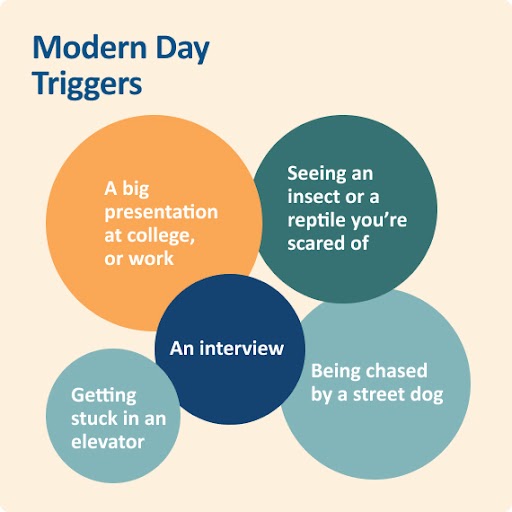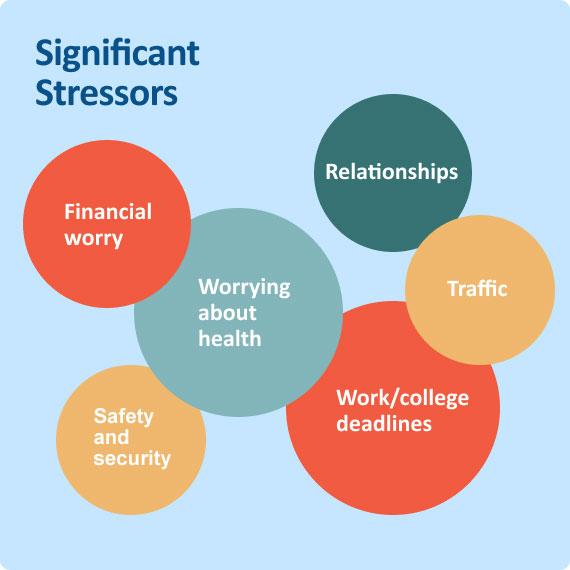Panic attacks
In today’s world, threats are wildly different from the likes of encountering a tiger in the wild. They could be:

When we are faced with the above situations, we experience shaky legs or “butterflies in our stomach”, this is the body’s fight or flight response working. After the danger, or the feeling of danger passes, so does the discomfort.
But there are other things that can cause us significant stress.

These worries tend to stay over time and repeatedly cause us stress. When heightened stress levels are constant, our brain’s ability to deal with them gets impaired—and we end up experiencing the symptoms of the fight or flight response, even when there is no threat around us. This experience is known as a panic attack.
A panic attack is an intense episode of fear that can feel very uncomfortable—for the person experiencing it—due to the overload of symptoms in different parts of the mind and body.
Symptoms of panic attacks
Physical
- Increased heart rate
- Trembling
- Nausea
Brain Function
- Inability to focus
- Fear of dying
- Memory lapses
Emotions
- Urge to cry
- Feeling worried
- Irritability
Thoughts
- “I’m going to lose control”
- “I’m going to faint”
- “I will never feel normal again”
The symptoms listed are only a few examples of what can occur during a panic attack. There are over a hundred symptoms that one could experience in varying degrees and combinations. A panic attack generally lasts for 20 minutes, and peaks at the ten-minute mark.
There are a number of things that one can do to calm down during a panic attack.
How to calm down if you’re having a panic attack
Deep breathing exercise
When we are having a panic attack, our lung functions increase and this causes us to take breaths very quickly. This leads to a decrease in the normal CO2 levels in our blood which causes the cognitive symptoms of a panic attack. Consciously taking deep breaths can normalize these levels, and help stop the panic attack.
To do this exercise, take a deep breath through your nose. Hold it for five seconds and then slowly exhale through your mouth by making an ‘o’ shape with it. Repeat, until the panic attack subsides.
54321 exercise
The 54321 exercise is a grounding exercise. Grounding exercises are techniques that help the brain realize that there are no real threats around us. This is accomplished by consciously using all of our senses—touching things around us, feeling the ground with our bare feet, smelling the air, paying attention to the sounds around us, and keenly observing our surroundings.
- 5 things you can see
- 4 things you can feel
- 3 things you can hear
- 2 things you can smell
- 1 thing you can taste
How to help someone who is having a panic attack
Watching someone have a panic attack can be a puzzling experience. Knowing well that there is no imminent threat, you may not understand why the person is feeling such intense fear. Here are some things you can do to help them through the attack:
Remind them that this will pass
A panic attack generally lasts for 20 minutes. Constantly remind them that this is temporary and it will pass.
Distract them
You can help them ground themselves, by asking them to feel, smell, see, and hear the things around them and describe them to you.
Do not ask them to calm down
The sensations that they are going through are not in their control. They will not be able to calm down no matter how much you ask them to.
Do not ask them why
There may not be an actual threat that is causing the fear. Asking them why might make them feel even more uncomfortable and worsen their symptoms.
Encourage them to take deep breaths
Do a deep breathing exercise with them.
Use a panic assistance track
A panic assistance track is a recording of a guided meditation which can help ground and calm the person. Many such tracks are available on the internet and streaming apps.
We may experience a panic attack at some point in our lives, and never have one again. If you are experiencing repeated episodes of panic attacks, call us or write to us at counselling@manntalks.org and talk to a mental health professional today.
 Call Mann Talks Now
Call Mann Talks Now


